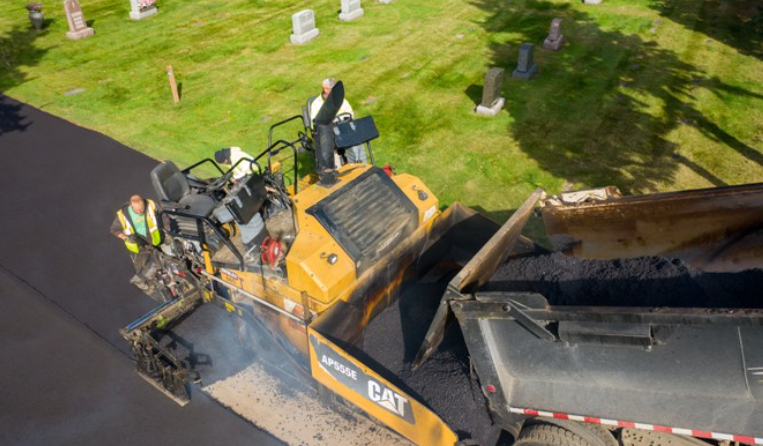Revolutionizing Roads: Technological Innovations in Asphalt Paving Mix Design and Application
by siteadmin

Asphalt paving has long been a cornerstone of modern infrastructure, providing durable and versatile surfaces for roads, parking lots, and driveways. However, advancements in technology are transforming the way asphalt mixtures are designed, produced, and applied, leading to more sustainable, efficient, and resilient pavement solutions. In this blog post, we’ll explore some of the cutting-edge technological innovations shaping the future of asphalt paving mix design and application.
Warm Mix Asphalt (WMA) Technology:
Warm mix asphalt (WMA) technology has emerged as a game-changer in the asphalt paving industry, offering numerous advantages over traditional hot mix asphalt (HMA). WMA allows asphalt to be produced and placed at lower temperatures compared to HMA, resulting in reduced energy consumption, lower emissions, and improved workability. By incorporating additives or foaming agents into asphalt mixtures, WMA technology enables better compaction, longer hauling distances, and extended paving seasons, making it a more sustainable and cost-effective paving solution.
High Recycled Material Content:
In response to growing environmental concerns and resource constraints, asphalt producers are increasingly incorporating recycled materials into their mix designs. Recycled asphalt pavement (RAP) and recycled asphalt shingles (RAS) can be reclaimed and reused in new asphalt mixtures, reducing the demand for virgin aggregates and conserving natural resources. Advances in milling, crushing, and screening technologies have made it possible to process and incorporate higher percentages of recycled materials into asphalt mixtures without compromising performance or durability, leading to more sustainable pavement solutions.
Polymer-Modified Asphalt Binders:
Polymer-modified asphalt binders offer enhanced durability, flexibility, and resistance to cracking and rutting compared to conventional asphalt binders. By incorporating polymers such as styrene-butadiene-styrene (SBS) or styrene-butadiene rubber (SBR) into asphalt mixtures, pavement engineers can tailor the rheological properties of asphalt binders to meet specific performance requirements. Polymer-modified asphalt mixtures exhibit improved fatigue resistance, thermal stability, and moisture resistance, making them ideal for high-traffic areas, heavy-duty pavements, and challenging environmental conditions.
Intelligent Compaction Systems:
Intelligent compaction (IC) systems are revolutionizing the way asphalt pavements are constructed and compacted. These advanced systems use real-time monitoring and control technology to optimize compaction efforts and ensure uniform density throughout the pavement layer. By incorporating GPS, accelerometer, and temperature sensors into compaction equipment, IC systems provide contractors with valuable data on pavement stiffness, density, and temperature, allowing them to achieve higher levels of compaction efficiency, consistency, and quality. IC technology improves pavement performance, reduces material waste, and minimizes the need for costly rework, leading to more sustainable and resilient asphalt pavements.
3D Printing and Additive Manufacturing:
Emerging technologies such as 3D printing and additive manufacturing are poised to revolutionize asphalt pavement construction in the future. By using computer-aided design (CAD) software and robotic printers, researchers and engineers can fabricate customized pavement structures with intricate geometries and tailored properties. Additive manufacturing techniques allow for precise control over material composition, layer thickness, and surface texture, enabling the production of innovative pavement designs optimized for performance, sustainability, and longevity. While still in the experimental stages, 3D printing holds great promise for revolutionizing asphalt paving practices and unlocking new possibilities for sustainable infrastructure development.
Technological innovations in asphalt paving mix design and application are reshaping the landscape of modern infrastructure, paving the way for more sustainable, efficient, and resilient pavement solutions. From warm mix asphalt and high recycled material content to polymer-modified binders, intelligent compaction systems, and 3D printing technologies, the future of asphalt paving is brimming with possibilities. By embracing these cutting-edge advancements, the asphalt paving industry can continue to deliver high-quality, cost-effective, and environmentally friendly pavement solutions that meet the evolving needs of our communities and ensure a brighter future for generations to come.
Asphalt paving has long been a cornerstone of modern infrastructure, providing durable and versatile surfaces for roads, parking lots, and driveways. However, advancements in technology are transforming the way asphalt mixtures are designed, produced, and applied, leading to more sustainable, efficient, and resilient pavement solutions. In this blog post, we’ll explore some of the cutting-edge…
Recent Posts
- Balancing Act: Environmental Impact and Sustainability in Asphalt Paving
- Smooth Moves: Asphalt Paving Maintenance Strategies for Sustaining Smoothness
- Innovating Asphalt Paving: Exploring Advanced Asphalt Mix Design Methodologies
- The Importance of Pothole Repair: Health Impacts of Pothole-Related Accidents
- Understanding Chemical Exposure and Its Impact on Asphalt Degradation
